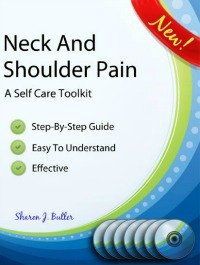Neck and Shoulder Pain
You may have neck pain. You may have shoulder pain. But what you may not realize is that they are often connected. They are “talking” to one another.
When you try to correct one without also trying to correct the other, very often your results are less than you had hoped for. So, in this website, we are going to look at the relationship between neck pain and shoulder pain so that you can finally be free of the discomfort that affects your life.
The shared connection between neck and shoulder pain is through the fascia, the connective tissue that weaves its way in and around the muscles of the neck and shoulders (and the rest of the body as well).
Nearly all of the major muscles that create pain for you in your upper body have one end connected to the neck bones and the other end is connected to the shoulder bones. The only exception to this is muscles around the shoulder blades which we will deal with in this section also.
Changes in the fascia of the neck is why, when you have a stiff neck, you end up feeling the pain “spreading” down into your upper back and shoulder areas.
Fascia communicates with and connects all parts of the body through your nerve pathways as well as through the quality of your movement. So when one area is affected by pain or stiffness, the discomfort and/or the limitations in movement will be transmitted to other nearby tissues. Thus, the spreading pain.
Dealing with both the neck and the shoulders in this section just makes sense.
How Do You Find Relief?
To get the most pain relief when you have neck or shoulder pain, it is best to correct the balance of the whole area, so that you address the pain that you feel as well as the areas that have gone through some compensating changes, but that you may not necessarily feel at this point. It’s all affected and it all needs to be restored back to normal.
You can find more information on things you can do on your own to relieve your neck and shoulder pain on the Self Care page.
In this section on Neck and Shoulder pain, my purpose is not to diagnose or offer treatment to your upper body. Rather, I find it is most effective if you can clear away the things that are getting in the way of your body healing itself, sort of like home remedies for neck and shoulder pain.
Your body knows best what is out of balance, damaged, or weakened due to changes in your connective tissue infrastructure. If you give it just the right input, your body is capable of making the necessary corrections and doing it safely, quickly and effectively.
"I started using Sharon Butlers program about a month ago. I'm using the Neck and Shoulder program, and after 3 days my constant shoulder pain went away!"
- Luz
What Causes Neck and Shoulder Pain?

Click HERE to Learn More!
Posture
Did you know that your head weighs approximately ten pounds? It’s the job of your neck and shoulder muscles to hold that ten pound ball up all day. That job becomes more and more difficult with slouching, tilting your head, bad furniture design, poor car or airline seats, holding a baby on one hip, carrying a heavy bag or backpack, even a woman’s shoulder purse can have a negative effect!
In order to fully recover from neck and shoulder pain, it is critical that you make as many corrections to your bad posture as possible. Reducing that source of chronic strain can have an incredible impact on reducing the amount of pain you feel on a daily basis.
Trauma
There are all kinds of trauma that can affect or cause neck and shoulder pain. It could be as far back in your history as falling off a bicycle at a young age. You might have suffered whiplash from a car accident. Sports injuries can take a huge toll. And surgery creates a big opportunity for adhesions (stuck spots) to develop.
When traumatic events happen, it is natural to create a new way to hold yourself, do things differently with your hands, shift your posture, etc. as a way to avoid what hurts, or to compensate for changes in your body as a result of your trauma.
Often, without knowing it, we make these changes into new habits and they, in turn, create new forms of stress for our bodies. Becoming aware of these newer habits and compensations might lead you to understand more about the neck and shoulder pain that you now suffer from.
Finding a way to get back to more balanced posture, better movement patterns and less overall body stress will help to significantly reduce your pain levels.
One of the best ways to undo the damage that has been created by trauma is to start doing stretches that can help restore balance to your body. This helps lessen the effects of any adhesions that developed from the trauma itself, or the compensations that you made because of the trauma.
Yoga is excellent for improving overall flexibility and range of motion. Twisting and turning in all sorts of directions quickly loosens tight and restricted fascia. Look for a teacher who is experienced in upper body pain to get the best results.
For beginners, or those who have a great degree of stiffness or limitation, one of the best things I have found is something called “Undulation”. Undulation is gentle, slow, wave-like movements that very gradually shift your posture and restore all your body limitations back to a more normal level.
"I think the most important part of this program is learning to stretch properly. I struggled with RSI for two years and saw many Physical Therapists during that time. They all showed me stretches to do, but never showed me HOW to stretch. I finally learned how to stretch properly through Sharon Butler's Self Care Program. Her stretches WORKED. And, now that I know how to stretch, the PT stretches work too! I recommend going through this program before anyone goes to the Physical Therapist for the first time. It’s just too easy to stretch improperly and make things worse. I see others make the same mistakes I did."
- E. Warendorf, Germany
Personal Habits
We all develop ways of sitting, standing, working, resting and sleeping that feel “comfortable” or “usual” to us. But, sometimes the habits we create for ourselves can be destructive too.
When these habits throw your body out of its natural alignment, create strain, or force you to hold your head and neck in uncomfortable or unnatural positions, neck and shoulder pain is likely to develop as a result.
It’s not always easy to recognize these patterns in ourselves. Often, those around us are much more prepared to let us know what they have seen us do, ways that we hold ourselves, or habits that we have developed that might be causing or contributing to our pain.
If you feel you cannot put your finger on the things you do or the ways you move that cause your pain, ask those around you for their opinion. Often, they can show you what you are doing, or duplicate how you are moving so you can become more aware of your stressful patterns. Changing these patterns back to a more balanced way of moving or using your body will reduce the chance for neck and shoulder pain.
Where Is Your Neck And Shoulder Pain?
Contact me via the Contacts page if you have questions about any of the following types of neck and shoulder pain:
- Pain on the side of the neck
- Pain under the ear
- Pain under the jaw
- Pain behind the ear
- Pain in the shoulder blade area
- Pain between the shoulder blades
- Pain in the front of the neck
- Pain at the top of the shoulder and into the neck
- Neck pain after sleeping
- Choosing the right pillow for neck pain
- Herniated disc neck pain
- Personal habits that contribute to neck and shoulder pain
- Dowagers hump
- Ear and Neck pain
- Cell phones and neck and shoulder pain
- Sharp shooting pain in the neck
- Home remedies for neck pain
- Severe neck and shoulder pain
- Stiff neck pain
- Morning neck pain
- Frozen shoulder
To learn more, visit the following pages:
Neck and Shoulder Pain Symptoms
Neck and Shoulder Pain Anatomy
Neck and Shoulder Pain Self Care
Click the block below that most closely matches your injury for more information and to find the Toolkit we offer to help you in your recovery.







